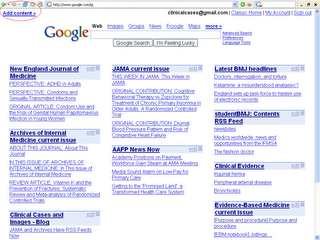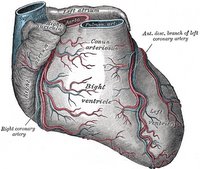 Online medical education has changed significantly during the last 2-3 years. When I first started lecturing about using Web 2.0 in Medicine in 2005, few members of the audience had ever heard of podcasts and even fewer shared my enthusiasm for them as a medium for continuous medical education. Fast forward 3 years later, and now some doctors wonder if they should even go to a conference if they can just download the podcasts... More and more institutions make their grand rounds and conferences available for free via downloadable audio and video files.
Online medical education has changed significantly during the last 2-3 years. When I first started lecturing about using Web 2.0 in Medicine in 2005, few members of the audience had ever heard of podcasts and even fewer shared my enthusiasm for them as a medium for continuous medical education. Fast forward 3 years later, and now some doctors wonder if they should even go to a conference if they can just download the podcasts... More and more institutions make their grand rounds and conferences available for free via downloadable audio and video files.A few examples of useful podcasts for medical education are listed below:
University of Tennessee Internal Medicine Residency Program
Three years of grand rounds and noon conferences of the internal medicine residency program of the University of Tennessee have been recorded and posted as podcasts on this website. You can listen to the podcasts directly or subscribe vai iTunes. The podcasts are searchable by topic. This is probably the most useful and comprehensive podcast resource for residents and medical students. Highly recommended.
The are 268 audio lectures published on the UTHSC website as of January 2008 which cover most of the curriculum in internal medicine. The podcasts are available for free compared to the audio review courses by major institutions such as Johns Hopkins which cost $200-1,200.
The authors of the project use Libsyn (Liberated Syndication) as a host which is a good place to start if you want to produce your own podcast. Libsyn plans start from $5 per month with unlimited downloads and an upload limit of 100 MB per month. The UTHSC podcasts are encoded at 16 kbs, mono, 22 kHz which does not provide the best sound quality but produces very small files (3-5 MB for a 30-60-minute talk). The total size of all 268 podcasts is 1.3 GB. Libsyn supports RSS and the extended Apple iTunes podcasting tags.
Other Medical Podcasts
Texas Tech Medcast
The Texas Tech Medcast is a podcast for medical residents, medical students and practicing physicians. It has several series:
- SOAP Note 101 Series: designed for first-year medical students who are learning how to write an effective patient note for a medical record (SOAP)
- Geriatrics Series
- Continuity Clinic Series
- Diabetes Mellitus Series
- PreMed Forum Series
Boston University General Internal Medicine Rounds
Weekly selection of the General Internal Medicine Grand Rounds from Boston University Medical Center. The project is still in early stages of development and only a few podcasts are available.
Yale Medicine Podcast
Visit itunes.yale.edu or launch iTunes, then select Yale from the offerings under iTunes U. The podcast is included under “Yale Health & Medicine.”
EMS Lecture Series by Albany Medical Center
Online continuing education courses for EMTs and emergency medicine residents.
PeerView Podcasts
Podcasts in different specialties by the supplier of continuing medical education activities PeerView Press.
MedPod101
Podcasts in different specialties by 3 doctors. The project is still in early stages of development.
References:
Medical podcasts: the future of continuing professional development? BMJ Career Focus 2008;336:29-30.
How to Use Web 2.0 in Medicine? Clinical Cases and Images - Blog, 05/2006.
Top 5 Medical Podcasts I Listen To. Clinical Cases and Images - Blog, 08/2006.
Related:
How to Embed MP3 Audio Files In Web Pages With Google or Yahoo! Flash Player. Digital Inspiration, 02/2008.
The iCritical Care Podcast: a novel medium for critical care communication and education. Journal of the American Medical Informatics Association 2007;14(1):94-99.
Joining the Podcast Revolution. J Dent Educ. 72(3): 278-281 2008.
Updated: 03/07/2008
























